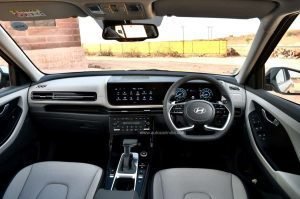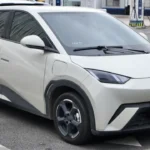As the Indian auto market booms, manufacturers are rapidly adapting to the electric vehicle (EV) trend. Both local and multinational automakers are diving into the EV sphere in the world’s third largest auto market. Tata Motors has led this transition in recent years, introducing multiple EVs across different segments. Currently, Tata Motors dominates the Indian EV market, but competition is heating up, especially from Korean manufacturer Hyundai, which has been active in India since 1996.
Hyundai Motors India has achieved solid sales in the Indian EV market, thanks to models like the Kona and Ioniq 5. Now, the company is set to expand its legacy by introducing a compact SUV into the EV space. The top selling compact SUV, the Creta, which recently received a facelift, is now set to get an electric avatar. The Hyundai Creta EV has been spied testing under camouflage multiple times, but the latest spy shots confirm it as a production spec model.
According to reports, Hyundai plans to expand its EV lineup in India, with the all-new Creta EV, expected to launch globally early to mid-next year. In this article, we’ll explore what the Hyundai Creta EV will bring compared to the current Creta Facelift available in India.

Looks:
The 2025 Hyundai Creta EV will share its underpinnings with its internal combustion engine (ICE) counterpart. However, to set the EV apart, Hyundai will make some noticeable changes to its exterior. The front profile might retain the same headlamp design, including the connected LED strip for the DRLs. The front grille is expected to see some styling tweaks distinct from both the regular and N Line Creta Facelift. Aerodynamic bumper designs might also differ. The rear profile will likely remain similar, retaining the connected LED tail lamps. Additionally, the alloy wheels could be inspired by the Kona or Ioniq 5.
Specs:
The major change, Hyundai Creta EV is expected to boast is, the replacement of Turbo petrol and Diesel powertrain with a rumored 45kwh battery pack, which is expected to offer a range of about 450 km on a single charge, although real world range figures ,ight differ. Hyundai has partnered with Exide for the batteries. The car might use the same electric motor as the Kona, which produces the figures of 138 hp and 255 Nm.
Interior:
The interiors of the Hyundai Creta EV test mule resembles its ICE counterpart, but the upholstery might draw inspiration from the Ioniq 5 and Tucson. According to sources, the traditional three spoke steering wheel will be replaced with a two spoke design inspired by the Ioniq 5. The cabin could be available in either single-tone beige-black or a dual-tone option.
Features:
The Hyundai Creta EV will share the same connected infotainment system and Alcazar UI-based 10.25-inch fully digital instrument cluster, which also supports multiple drive modes. It will retain features like dual-zone climate control, rear AC vents with blower controls, wireless charging, ventilated front seats, a 360-degree camera, a Bose surround sound system, electronically adjustable front seats, auto-dimming IRVM, panoramic sunroof, and ADAS Level 2. It remains unclear whether the dash cam offered exclusively with the Creta N Line will be included with the Creta EV. However, there will be no electronically operated tailgate or heated ORVMs on offer.






